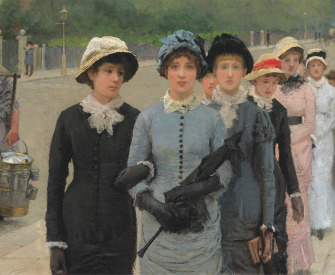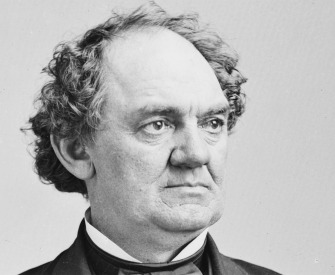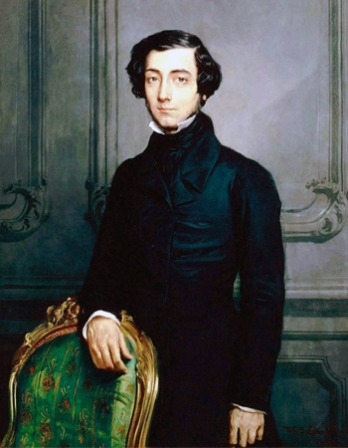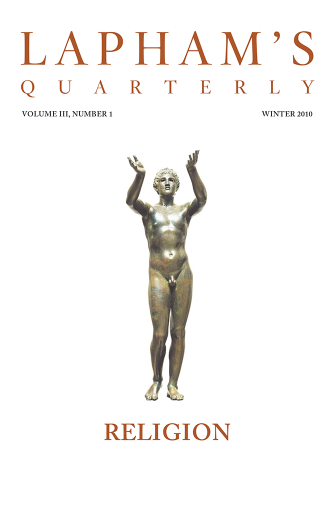Man is the only animal that can remain on friendly terms with the victims he intends to eat until he eats them.
—Samuel Butler, 1890How to Be a Stuffed Animal
The American Museum of Natural History, Teddy Roosevelt, and the importance of taxidermy.
By Frances Stonor Saunders
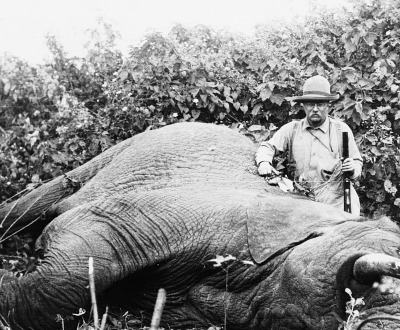
Theodore Roosevelt and an elephant killed on the former's African safari trip, c. 1909.
The fire that destroyed P. T. Barnum’s American Museum was the spectacle to end all spectacles. It started in a basement shortly after noon on July 13, 1865, and spread with an energy befitting the museum’s restive owner. By midafternoon it had attracted an audience of thirty thousand to the corner of Broadway and Ann Street in Lower Manhattan. As the Prince of Humbugs’ palace of wonders hissed and cracked and roared under the pressure of its own combustion, so the crowd responded to the conflagration with cheers and shrieks and “uncontrollable laughter,” reported the New York Times.
Gone were the flea circus, the loom run by a dog, the trunk of a tree under which the disciples of Jesus had sat, the hat worn by Ulysses S. Grant, the waxworks, the Feejee mermaid, the taxidermy displays of “monkeys in all imaginable attitudes, stuffed and waxed and furnished with curiously wrought glass eyes, sacred white cows filled with hay, monstrous turtles varnished and stuffed, camels with humps, zebras with the traditional 365 stripes, lions with shaggy manes, and tigers with beautiful skins.” These, and tens of thousands of other curiosities and collectibles, the entire contents of Barnum’s Wunderkammer, were all incinerated.
The human exhibits survived, exiting the building in varying states of disarray to the delight of the expectant crowd: out came Josephine the Bearded Lady, Jo-Jo the Dog-Faced Boy, Miss Swan the Giantess, the blackface minstrels, the midgets, magicians, ventriloquists, and the fire-eaters whose skills were of no use in the current situation. On their dash to safety along corridors and down stairwells, they had to overleap the anacondas, pythons, and other gigantic snakes whose large shared cage had capsized, sending its tenants to wander wherever they fancied. The snakes’ newfound liberty was cut short when police officers shot them as they ventured onto Broadway. An alligator billed as the “Man Eater” was observed by firemen as it blinked at the unfolding drama and made no attempt to escape (or to eat a man). He perished, as did all the other animals except for Ned the Learned Seal. Two whales imported at great expense from the coast of Labrador met “a fearful death by roasting” after firemen pumped the water out of their tank to quell the fire. Gone too were the “sassy monkeys, subdued dogs, meek rats, fat cats, plump pigeons, sleepy owls, prickly porcupines, gay guinea pigs, crowing cocks, hungry hounds…all burned to death, roasted whole, with stuffing au naturel, and in view of their lamentable end we may well say, ‘Peace to their ashes.’”
Nobody could draw a crowd like Barnum. Since opening the museum in 1841, he had coddled and cajoled as many as fifteen thousand visitors a day, each paying twenty-five cents to be astonished or disgusted or deluded (those curious to see the “Egress,” for example, who, after following the sign, found themselves outside on the sidewalk and had to pay a second time to reenter the building). Some 38 million customers visited the museum in its lifetime, more than the total population of the United States at that time. There was much humbuggery—the Feejee mermaid was in fact half baby monkey and half fish, sewn together and covered in papier mâché (a very well-executed fake)—and Barnum’s sensationalism, his unfaithful relationship to the “real,” had long been anathematized by starchy educators. And yet, as the cinders of the museum mingled with the dirt of Broadway, it was begrudgingly conceded it had “deserved an honorable place in the front rank of the rare and curious collections of the world.”
Barnum tried to recreate the museum on a different site a couple of years later, but this was also destroyed—again, mysteriously, by fire—leaving him to deplore the fact that “the whole vast continent of America stands today with scarcely an apology for a free public exhibition of natural history and art.” The disagreeable deficit was rectified in 1869 with the founding of the American Museum of Natural History on New York City’s Upper West Side. Graced with the patronage of a philanthropic aristocracy, its charter meeting was hosted in the parlor of Theodore Roosevelt Sr., whose young son Teddy was already a keen amateur naturalist.
The stuffed shirts who filled the museum’s trusteeships scorned any comparison to Barnum, but key elements of his enterprise survived their high principles of “Truth, Knowledge, Vision.” By the time the museum opened for business (with free admission) in 1877, it was clear that it favored “naked-eye” science that would be accessible “for the everyday man.” Disciplines like vertebrate zoology, ornithology, and anthropology, accompanied by large or striking specimens, were to be emphasized. Research was not a high priority—best to “leave that sort of thing to the Europeans,” said one trustee—leading some museum scientists to wonder whether their work was being called into support of exhibits whose primary function was to entertain.
Barnum, meantime, took his show on the road, crisscrossing the country with his “Grand Traveling Museum, Menagerie, Caravan & Hippodrome.” His prize draw was Jumbo, an African bush elephant purchased from the London Zoo for ten thousand dollars. Barnum was known to cheat reality, but he could also enlarge it: Jumbo’s London height was 10.7 feet, but upon being shipped to America he had become 13.1 feet. After being killed by a freight train in 1885, Jumbo grew again. Barnum decided to have him stuffed and mounted by the taxidermist Carl Akeley, who stretched the elephant’s skin to make him look bigger. It was a crude mount, glaringly artificial (Akeley later dismissed it as “upholstery”), though it ensured the postmortem career of the world’s most famous elephant, who continued to travel as before.
By the time Carl Akeley joined the taxidermy department of the American Museum of Natural History in 1909, he was producing exquisite mounts. The dull, listless unreality of his earlier work had given way to extraordinarily lifelike specimens, an effect he was able to achieve through pioneering methods of articulating the skeleton to characterize the animal’s mobility, behavior, and attitude. Where previously the skeleton had been discarded and the skin stuffed with straw, cotton, or wood shavings, it was now braced to an iron-and-wood armature to create an anatomical frame. This was cast in an underlayer of clay, which was worked up with a scalpel to express the internal biography of the animal, whose organic substance, including its lifeblood, had long since been lost. Muscles, veins, connective tissue, even wrinkles, were sculpted in meticulous detail (as an apprentice, Akeley had been taught simply to beat the detail into the stuffed mount with a plank of wood), at which point the animal was ready to receive its skin. Last to be added were the eyes (glass), tongue, and nose (resin or wax, varnished to suggest wetness). And there it stood—or leaped or prowled—more alive than dead, the perfect illusion of absolute reality.
The museum was now struggling with an imperfect reality. Behind the scenes, in the taxidermy studio, a kind of renaissance was taking place in which anatomy, biology, physics, and art were being fused with thrilling results. By contrast, front of house was a rather gloomy affair. Where Akeley had discovered how to recreate a moment in time, to conjure the eternal present, the old stuffed animals, ranged row upon row in vast halls and corridors, were locked in a kind of medieval mortmain—there was more life in the dust motes that rose from their lackluster hides and traveled in the slipstreams of sunlight. The exhibits were “shabby and inadequate,” chafed one trustee, and many were discreetly retired to the museum’s stores.
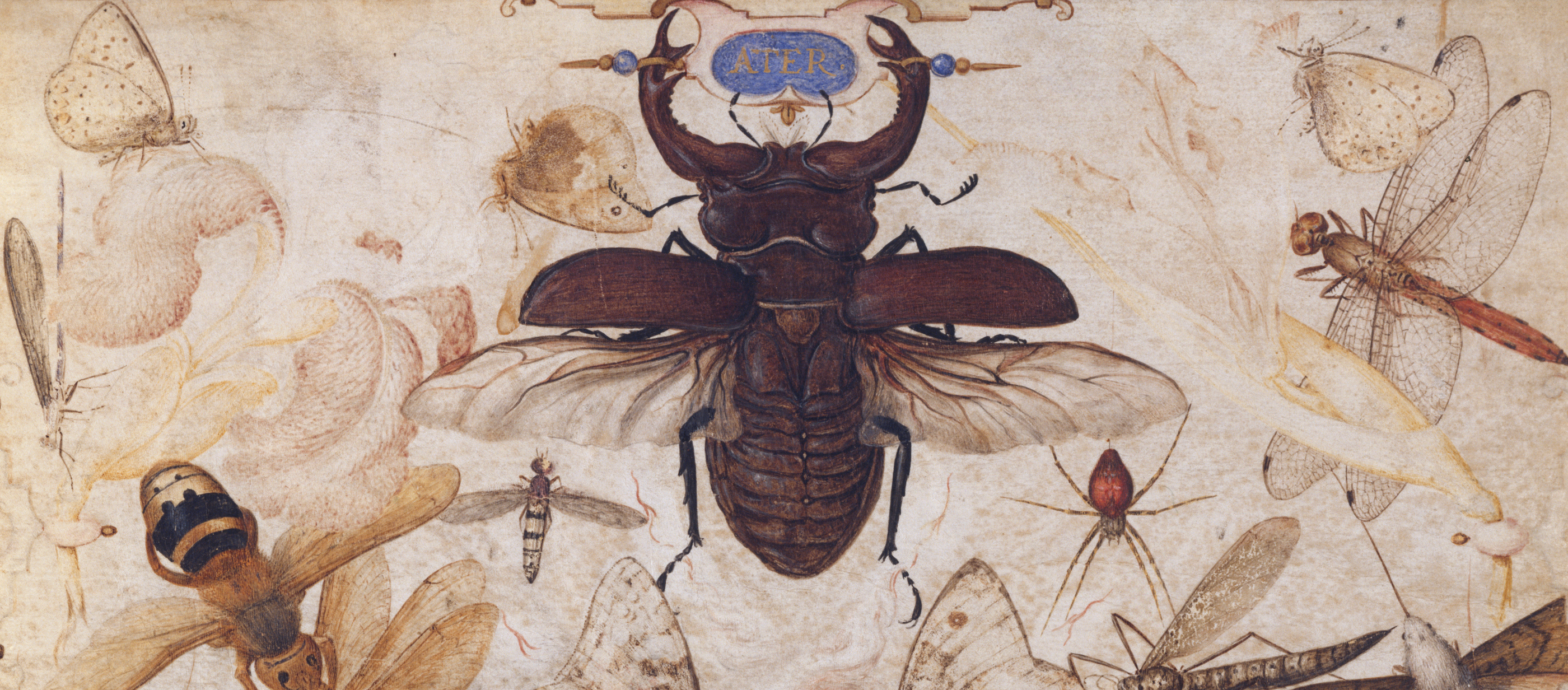
Insects and the Head of a Wind God, by Joris Hoefnagel, c. 1595. The Metropolitan Museum of Art, Gift of Mrs. Darwin Morse, 1963.
The cull was bad news for the stuffedanimals—they died a second time—and for their living relatives, who would now be required to replace them. Civilization’s threat to nature provided the museum with an urgent mission to educate the public about vanishing wildlife resources. As very few people had access to the wilderness, it had been determined that the best way to do this was to bring the wilderness to the people. Teddy Roosevelt’s African safari of 1909 to 1910, self-mandated as an exercise in conservation, returned over eleven thousand dead animals to the United States, a trophy bag that was divided among Roosevelt, his fellow “sportsmen,” and America’s preeminent scientific institutions. Through Carl Akeley, who accompanied Roosevelt on the expedition, the AMNH took possession of hundreds of big-game specimens, many of which were “collected” and “prepared”—shot, bled, disemboweled, skinned—in the field by Akeley himself. The bones had been boiled, the skins salted and soaked in formalin, the hoofs and horns measured and labeled, and the disassembled parts crated and shipped to the Upper West Side. There, on Akeley’s production line, the remains were reassembled and processed into a perfect likeness of what had once been, a “real” copy of reality. The animal had become an “animal.”
Akeley spent long periods in the field over the following two decades. As a taxidermist he lusted for the perfect specimen, as a naturalist biologist he was able to spot it, and as a crack marksman he could deliver it. “Every animal that comes within [shooting] range is carefully scrutinized as to sex, age, condition of skin, and various phases of coloration or character,” explained Akeley’s colleague James L. Clark. This obsession with the “typical” specimen, a description that was confused with excellence, meant that ageing, sickly, or otherwise imperfect beasts were passed over. In an inversion of Charles Darwin’s [London, page 55] drama of survival of the fittest, asymmetrical tusks could save a bull elephant’s life, “shabby pelage” that of a lion, “unprime antlers” an antelope. Biggest was always best—record trophies undermined satisfaction with smaller specimens, so females were less likely to be selected than males. A clean shot was essential: a badly placed bullet would damage the hide, denature it. “Taxidermy,” as Donna Haraway, a philosopher of science and technology, has written, “fulfills the fatal desire to represent, to be whole.”
Akeley thought nothing of risking his own life to acquire the perfect specimen, and he energetically publicized his adventures—how he was gored and trampled by a charging elephant and left for dead, or how, while being mauled by a leopard he managed to strangle the life out of it with his bare hands. Proximity to the target was a spiritual as well as a practical requirement: to look the opponent in the eye inferred a kind of equality, a brief moment in which the hunter-scientist, nature’s “advocate,” could communicate his respect and the beast could apprehend the nobility of its own death. (After killing his first silverback mountain gorilla, Akeley said he felt “like a murderer.” It was a rare fit of conscience from which he soon recovered, going on to kill several more, including infants.) This was the contract; the animal must die in order to be restored to life, in which reanimated (though motionless) state it would be better equipped to warn humans about how harmful they were to animals.
The wholeness of this vision, what Haraway calls “a politics of reproduction,” demanded a literal copy not only of the animal, but of its habitat. “Every herb and flower of the field has its specific, distinct, and perfect beauty,” the critic John Ruskin preached. “It has its particular habitation, expression, and function…Every class of rock, every kind of earth, every form of cloud must be studied with equal industry and rendered with equal precision.” Natural realism, to succeed, had to effect the collision of the wondrous with the systematic. Akeley treated the landscape, as much as the creatures that roamed it, as evidence to be collected and sent home, where it could be processed into a beautiful reiteration of the original. A site was chosen and photographed—captured—and sand, rocks, grasses, shrubs, and trees were gathered so that the scene could be faithfully reconstructed in the studio. Scores of artisans employed by the museum’s department of preparation took delivery of these “accessories,” which were then preserved or, where this was not possible, painstakingly duplicated over many months.
In a lozenge-shaped hall just beyond the main entrance to the museum, builders constructed a series of chambers to house the “habitat dioramas.” Each chamber was fitted like an alcove with a 180 degree curved wall, providing maximum depth-projection for the artists who were commissioned to paint the backdrop—the Serengeti Plain, or a bank of the Upper Nile, the slopes of Mount Kenya, a forest beside the Zambezi River. The foreground, raised on a concealed platform, was then dressed with the accessories, every stone or tuft of grass positioned exactly as it had been in the wild, and finally the mounted animals were introduced. The taxidermists fussed lovingly over their creations—kudu, cheetahs, nyala, rhinoceros, lions, giraffes, chimpanzees, mandrills—giving their coats a final brush, spraying a bit more fixative here or pigment there, before stepping out of the front of the chamber (out of Africa, so to speak), which was then sealed with a panoramic plate-glass viewing window.
Animals are good to think with.
—Claude Lévi-Strauss, 1962At its completion in 1936, the Hall of African Mammals, also known as the Akeley Hall, consisted of twenty-eight dioramas arranged in two tiers around a freestanding central tableau called “The Alarm,” a herd of eight elephants poised to charge out of the hall’s vast portal. The hall was dimly lit, its outline barely discernible, so that the internal glow of each diorama was accentuated. The effect was of a static carousel seen from the inside: nothing moved except the visitor. The animals, held in their poses forever, fixed their gaze toward a distant horizon of veld, forest, or mountains; some were turned to face the viewer beyond the glass, as if arrested by the possibility of an intruder. Akeley’s silverback gorilla rose to his full height against a backdrop of the Congo’s steaming Kivu volcanoes, beating his chest to announce ownership of this territory.
“Consider the cattle, grazing as they pass you by,” Friedrich Nietzsche wrote. “They do not know what is meant by yesterday or today; they leap about, eat, rest, digest, leap about again, and so from morn to night and from day to day, fettered to the moment and its pleasure or displeasure, and thus neither melancholy nor bored. This is a hard sight for man to see, for though he thinks himself better than the animals because he is human, he cannot help envying them their happiness.” Man, Nietzsche believed, suffered from the “malady of history”; he knew too much, was “made ashamed or fretful or sleepless by thought.” The nonhuman animal was not required to reflect; it “lives unhistorically, for it is contained in the present, like a number without any awkward fraction left out.” It is this, the unmediated full moment, the “forgetfulness” of the animal, that the diorama seems to capture.
And yet, for the human, the moment passes, a thought intrudes like a mugger: consciousness insists that this is a memory, a quotation of reality and not the thing itself. In these silent, airtight time capsules, there is no breeze to stir the animals’ pelage or alert them to a predator. Their nostrils do not twitch, their hearts do not beat. They represent the production of permanence, and this is their melancholy fate. They cannot speak, but they tell us something: Remember we are dead; this is our burial chamber.
Johann Wolfgang von Goethe once recounted the story of an Englishman who kept several hundred birds in large cages and fed them daily. “Some of these died, and he had them stuffed. The stuffed birds pleased him so well that the thought occurred to him it would be better to kill them all and have them stuffed, and this whim he at once carried into effect.” If taxidermy is a form of anxiety, then the habitat diorama speaks to a full-blown reconstructive neurosis. It’s a kind of eschatological complex that draws its energy from the fantasy of an original, pristine world—a Garden of Eden—that is fatally compromised and can only be retrieved by a philosophy of duplication.
The plan to recreate the American wilderness in the AMNH through taxidermy was first developed in 1942. The museum’s patrons and trustees, trophy hunters almost to a man, rallied to the proposal for a Hall of North American Mammals. Cornelius “Sonny” Whitney pledged $8,500 for a jaguar group, E. R. Harriman $5,000 for Virginia deer, Richard K. Mellon $12,000 for white sheep, Beverly R. Robinson $13,000 for mountain lions. Other groups, including moose, caribou, grizzly bear, Alaskan brown bear, and musk ox, were tendered for sponsorship—which secured the right to collect them—by an informal process of old school tie. When one trustee who was scheduled to hunt black bears in Florida was let down by his expedition companion (a Peabody), he proposed a replacement (a cousin by marriage) to the museum president (a friend). “If you felt you could write him a letter saying that the museum would like to have him undertake this job, I think it might put it across,” the trustee ventured. “A little flattery doesn’t hurt with him. He was Yale ’97 I think (Skull & Bones).”
An invitation to lead or join an expedition for the museum, thus cashing in the most desirable tag in the hunting world, was indeed flattering. The mammologist Roy Chapman Andrews, famous for his “intensive exploration” methods and, from 1934, director of the museum, was fond of reminding people that “thousands of men have applied for places on my own expeditions, saying that they are ‘good outdoor men’ but have no special training. They would be expensive luxuries. Every…man must do either a technical or a scientific job.” Newly bestowed with the gravitas of “specialists,” armed with large-bore guns made by Holland & Holland and permits obtained for them by the museum, outfitted in Abercrombie Camp, the blue bloods of American capitalism set off into the wilderness to atone for their fortunes (which had played a prominent part in endangering it) and find their inner Crocketts and Boones.
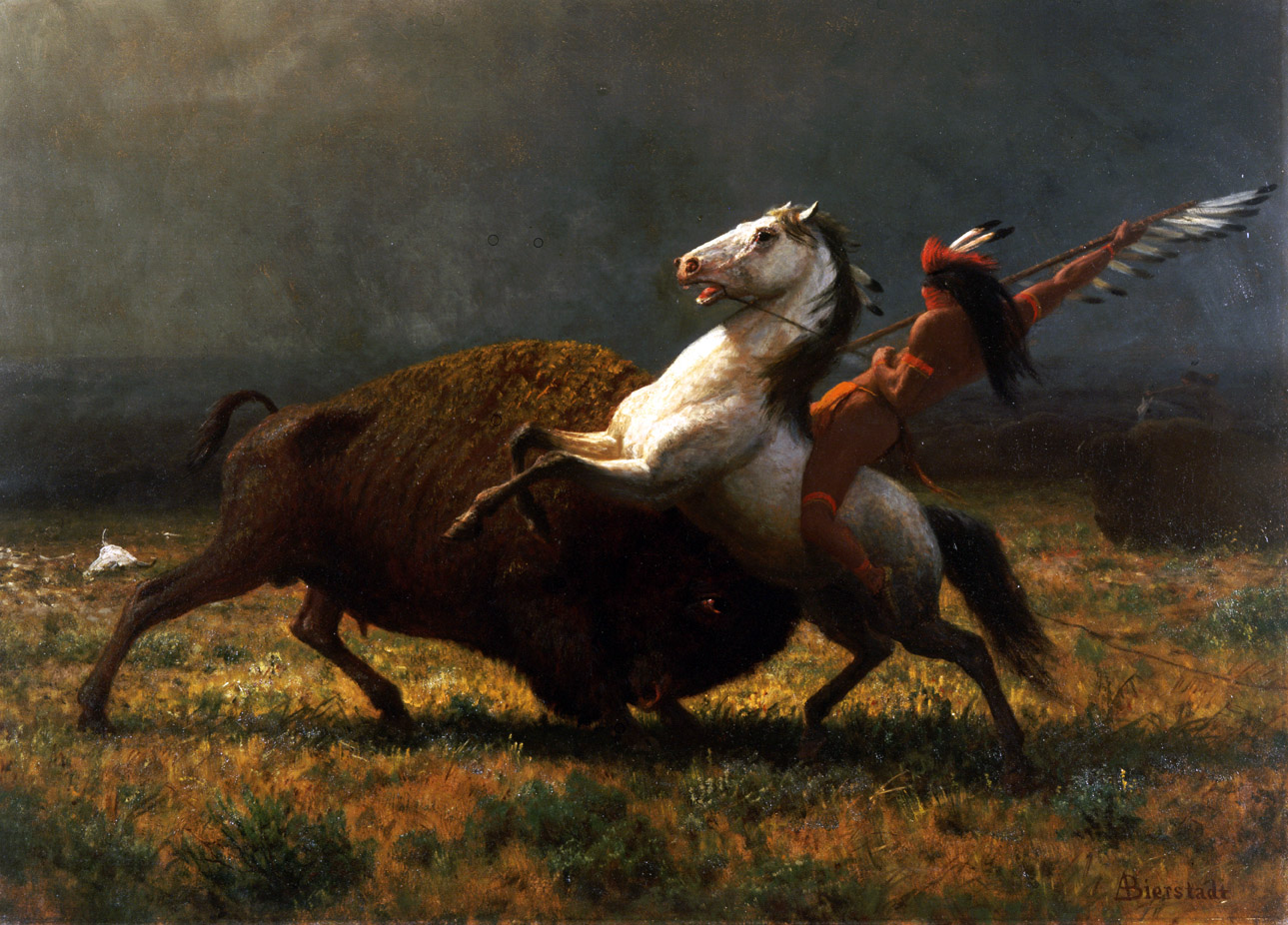
The Last of the Buffalo, by Albert Bierstadt, 1888. Photo: Christie’s Images © The Bridgeman Art Library.
Presiding over the whole enterprise was the spirit of Teddy Roosevelt, an ardent supporter of the museum until his death in 1919, and a major donor of specimens, including the large cow elephant displayed in “The Alarm” (Kermit, his son, shot the calf). Roosevelt self-consciously positioned himself in the tradition of Daniel Boone, the buckskin-clad hunter and frontiersman who helped settle Kentucky in the late eighteenth century, revering him as an indigenous (white) American who, like Davy Crockett, thrived in a free, egalitarian wilderness. These were “nature’s noblemen,” rugged libertarians and premier symbols of democratic manhood. Their descendants were the guides who accompanied the president—or general or railroad baron—and taught him the codes of the wilderness. Sharing a blanket with one of these guides was to enter an unrestrained, “uncontaminated” state where the social order was leveled. Roosevelt seriously believed that “no Americans of the outdoor type, fond of nature and the habitants of the wilds, will ever develop Bolshevik tendencies.” The wilderness experience was offered as a direct allegory of social peace, the guarantee of a negotiated tranquility. No matter that behind their backs the guides often mocked the men of fortune as “tenderfoots” or “dudes,” or that they had to defer to them when it came to bagging a trophy. There was equality in theory. In practice, it was a “teddy-bear patriarchy” in which droit du seigneur prevailed.
It is not known how many animals were shot by Teddy Roosevelt, the “conservationist president.” The number was certainly in the thousands. Mark Twain thought him morbidly fascinated with killing, a “hypocrite” who was “always hunting for a chance to show off; in his frenzied imagination the great republic is a vast Barnum circus with him for a clown and the whole world for audience.” Scientific respectability notwithstanding, showmanship and overkill were also implicated in the Hall of North American Mammals. Museum records show that each expedition for big game (there were eighteen, to locales as far-flung as the Arctic Circle, Mexico, Australia, and Alaska) returned more specimens than were needed. “We shot three bulls just to fill in the time,” the collector of Alaskan moose reported airily from the field. The inventory of “personal trophies” claimed on this expedition (led by Richard K. Mellon) mentions “3 caribou heads, 7 pairs horns, 2 pairs moose horns, 1 moose-head skin, 32 grizzly-bear skins and skulls, 1 black-bear skin and skull, 1 black-timber-wolf skin and skull, 1 coyote-head skin.”
James L. Clark, himself a celebrated taxidermist and the author of Good Hunting: Fifty Years of Collecting and Preparing Habitat Groups for the American Museum, penned a highly excitable account of the hunt for the cougar, or mountain lion, in the Grand Canyon. “Two specimens were all that we needed—a big male and a female. These two specimens should not be any two, but a selected or ‘hand-picked’ two,” he explained. A female and then a male were tracked and shot. “Now our group was assured. One might get a dozen lions and still not be lucky enough to get a male.” Clark had his specimens, but he had missed both kills and longed for his own bag. “Two weeks had now passed, and the following evening I was to return to New York, yet I had not even seen a lion,” he moaned. As luck would have it, on the final day, “The dogs suddenly gave tongue and started on the run…We all followed, galloping as fast as we could, dodging cedars and bush…Our blood boiled as we pressed on with loose rein at dangerous speed…Flashes of dogs were darting in all directions…[then I saw] a flash of yellow hide. We were on the lion at last!” The lion, a “big tom,” was eventually cornered by the dogs, and Clark took his shot. The creature turned out to be an “old warhorse,” with a five-inch scar across his face, a “big, festering hole” in one shoulder, and “many bits of shredded skin with tufts of hair” hanging from his coat. Thus disfigured, he failed the diorama entry criteria, but he had brought Clark the satisfaction of “a great hunt and a great battle,” and possibly a personal trophy (the records do not show).
Clark’s article, which appeared in the museum’s publication, Natural History, attracted a biting rebuke from one Sidney Parkinson, physician, who wondered “why the museum must send Dr. Clark on an elaborate expedition of new ‘hand-picked specimens’ when there [were] thousands of cougar pelts [left to] molder and collect dust in homes and museums the country over.” Parkinson concluded indignantly that “conservation of the cougar, or of any animal or bird, is not furthered by blood-stirring hunts…Least of all is science served by organized destruction of what few remain of one of our continent’s finest and handsomest creatures.” The letter is preserved in the archives and resonates for its singularity. There is no copy of an answer.
Histories are more full of examples of the fidelity of dogs than of friends.
—Alexander Pope, 1709Col. Francis Colby, collector of the Alaskan brown bear, had permits for only three specimens, but he returned five. These were added to the three bears the museum already had in storage from an earlier expedition. (Which begs the question: how many bears do you need to make a bear?) When Colby politely suggested he might be allowed to keep one for himself, the museum readily acquiesced. Nor did it demur from processing such personal trophies through its taxidermy studio. According to a memo headed “Rockefeller Leopard Skins,” one skin was “to be prepared with half head as a floor rug with nonskid material,” and a second, smaller skin “to be prepared as a rug for wall decoration” (a batch of claws were “somehow misplaced” by Rockefeller, but turned up in due course). Ashtrays from moose hoofs, coats from bearskins, antlers on shields were all regularly making their way from the Upper West Side to the stately homes of museum trustees (though few souvenirs surpassed Carl Akeley’s table, which could seat eight, fashioned from the ears of an elephant that nearly killed him and his wife, despite each of them shooting into his head about thirteen times).
In October 1937, Harold E. Anthony, the curator in charge of the Hall of North American Mammals, wrote to the museum’s director to express his alarm at the poor returns of a collecting expedition to Alaska. The trip had yielded just three goats, two porpoises, and “about half a dozen small mammals.” It was very obvious to Anthony that the material received was not worth the $13,500 of donations that had funded it. All the other mammals killed by members of the party, museum personnel included, “were considered to be personal trophies and were prepared as such.” Anthony worried that “to a [tax] inspector it will look as if the museum books have provided a handy place for a sizable sum spent on personal pleasure.” Even if the tax man were taken in by this fiscal humbuggery, he went on, native Alaskans would not be so easily duped: “The disposition of material taken on these trips always becomes known to the Alaskans because the guides tell about it later. To many Alaskans a museum expedition stands as an excuse for a lot of killing for certain privileged sportsmen operating back of a smoke screen.” Again, there is no record of a reply. Better, perhaps, to discuss such matters face to face.
In his essay “Travels in Hyperreality,” Umberto Eco ventures that the “genuine fake” prospers in America because it’s “a country obsessed with realism, where, if a reconstruction is to be credible, it must be absolutely iconic, a perfect likeness…It has to assume the aspect of a reincarnation.” During his pilgrimage through America’s “museums of memory,” he ponders the meaning of the full-scale model of the Oval Office at the Lyndon Johnson library in Austin, Texas. The model uses the identical materials and colors of the original, but everything is “obviously more polished, shinier, protected against deterioration.” It is, Eco ventures, “absolute unreality…offered as real presence,” where “falsehood is enjoyed in a situation of ‘fullness,’ of horror vacui.”
The habitat dioramas of the Hall of North American Mammals are less known than the Oval Office (real or “real”), but they are no less iconographic. They contain the essence of American national self-esteem, Henry David Thoreau’s “tonic of the wilderness” in a giant bell jar, offered as a palliative for all that anxiety about the pastness of the past. In each alcove, a majestic and symbolic native American species is displayed against a famous natural monument—Yosemite’s El Capitan and Bridal Veil Falls for the coyote group; Point Sublime, on the North Rim of the Grand Canyon, for the mountain-lion group; the Overland Trail, Wyoming, for the bison group; the Grand Canyon of the Yellowstone for the grizzly group. Every detail reflects the project’s doctrine of “absolute authenticity in reproducing nature.” The motto of James Perry Wilson, the project’s virtuoso landscape muralist, was ars celare artem, “art to conceal art,” so that “what is so painfully constructed appears effortlessly, spontaneously found, discovered.” Each single leaf—made from plastic or pressed from paper (brown wrapping, heavy Japanese vellum onionskin, or double-weight crepe), and hand colored—is unique, down to holes left by blight or worms. Just as in nature.
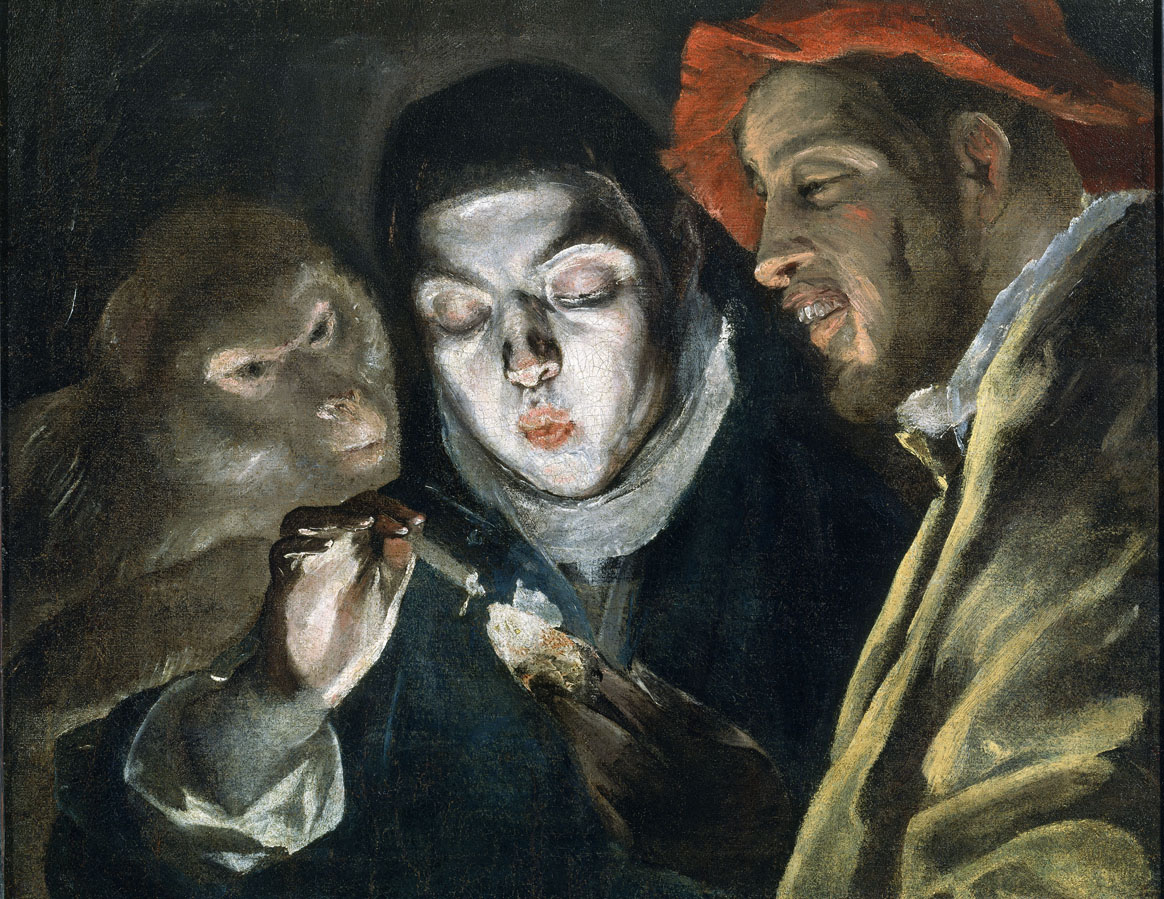
Allegory, by El Greco, c. 1600. Prado Museum, Madrid.
The hall opened with ten completed dioramas in April 1942. The floor plan called for twenty-nine alcoves (finally dedicated in 1954), but the trustees were impatient to reveal their first results. There was amour propre in this decision: those who had collected for the hall were now advancing in age and wished to see their trophies—some of them world records—enshrined before nature deprived the hunters of the opportunity. But there was another imperative: in a “period of worldwide turmoil,” the dioramas could be offered as a cultural and moral resource, a kind of antidote to “man’s destructive powers” and an invitation to “get back to first principles.” The stuffed animal had become a figure of Manifest Destiny whose job it was to lead man out of the nightmare of history and save the beginnings.
The museum scientists who carped that the dioramas were “totally devoid of intellectual content” had missed the point. “There are times when reality becomes too complex for oral communication,” says the computer in Jean-Luc Godard’s movie Alphaville. “But legend gives it a form by which it pervades the whole world.” Sometimes reality has to be seen to be believed, but it also has to be believed to be seen.
